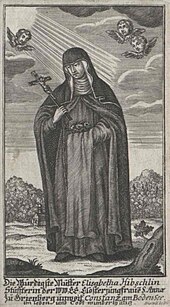Grünenberg Monastery
| Grünenberg Monastery | ||
|---|---|---|
| Creation time : | 11-16 century | |
| Conservation status: | nothing received | |
| Standing position : | Principality of Constance | |
| Place: | moss | |
| Geographical location | 47 ° 41 '43 " N , 8 ° 57' 3" E | |
|
|
||
The Grünenberg Monastery was a Franciscan - Terziarinnenkloster in today's municipality of Moos . It was in a valley between the towns of Gaienhofen and Weiler on the Höri peninsula .
Grünenberg Castle
The monastery was located near Grünenberg Castle, which was built by members of the episcopal ministerial family von Grünenberg , who belonged to the clan of the Knights and the Höri . The family can be traced back to the end of the 12th century; a connection with the later Constance patrician family of the same name cannot be proven.
The castle had a footprint of 10 meters by 35 meters. In the 14th century it was still inhabited, but in the 17th century it was already a ruin.
Foundation of the monastery
A hermit hermitage near Grünenberg Castle is first mentioned in 1282. At a time that can no longer be determined, the hermits were replaced by beguines . From 1344 (according to other sources in 1355) is a built on the site of the Beguine Klause Franciscans - Terziarinnenkloster . It was founded by Konrad Wolfgang von Lautfriedingen (probably Leipferdingen ). The noble Hübschlin von Ravensburg , who lived in Burg Grünenberg at the time , was also considered to be a co-founder of the monastery in 1380 due to his foundations. The good Klausnerin Elsa , also called Blessed Elsa , allegedly a Countess von Habsburg , who died around 1400 , also took place during this period . In the 15th century, the living conditions of the nuns in the monastery were modest, both spiritually and secularly. Only in the 16th century were other properties added, with the help of which the church was expanded.
history
The veneration of Blessed Elsa reached its peak in the 17th century, when miracles are said to have occurred after she was transferred to a more dignified grave. Legend has it that the monastery church was spared from the fire by the apparition of Blessed Elsa , to which all other monastery buildings fell victim in 1660. They were rebuilt with great effort until 1667, and various buildings were also renovated from 1732 to 1735 and 1754. As a result, economic problems emerged which finally led to drastic measures from around 1785, such as restricting choir prayers and selling unnecessary goods. Since no more novices were accepted either , only five very old nuns lived in the monastery.
Repeal
The monastery was closed in the course of secularization on November 3rd, 1808 and the remaining worldly goods were auctioned. In 1813 ecclesiastical goods such as pulpits , altars and bells were also sold. The last buildings of the Grünenberg monastery were demolished in 1830.
Today only a stone cross erected in 1895 on a meadow reminds of the location of the monastery. Various objects that can be found on the Höri and in the vicinity, such as the sacristy door of the church in Horn, are reminiscent of the monastery. In the parish church of St. Leonhard and Katharina in Moos (on Lake Constance) in the hamlet of Weiler there is a crucifix (around 1330) on the southern side wall and the bell of the monastery.
Individual evidence
- ↑ Burkhard Stege: Decay and dissolution of the Grünenberg monastery , in Wolfgang Kramer: Moos - history and stories of Bankholzen, Iznang, Moos and Weiler , p. 179, information 34.96.380, 52.84.095 in the Gauß-Krüger coordinate system
- ↑ Harald Derschka : Die Ministeriale des Hochstiftes Konstanz ( Konstanz Working Group for Medieval History: Lectures and Research ; Special Volume 45). Thorbecke, Stuttgart 1999, ISBN 3-7995-6755-0 , pp. 32-34.
- ↑ Franz Götz: Burg und Kloster Grünenberg , in Wolfgang Kramer: Moos - history and stories of Bankholzen, Iznang, Moos and Weiler
- ^ AG Tourismus im Landkreis Konstanz (Ed.): Bodensee. Churchgoers. Moss hamlet. Grünenberg Monastery. 2nd edition 2016, p. 31.
literature
- Wolfgang Kramer (editor): Moos - history and stories of Bankholzen, Iznang, Moos and Weiler . Hegau Library Volume 97, 1997.
- Badische Heimat, 13. Year, 1926: Untersee , p. 154

